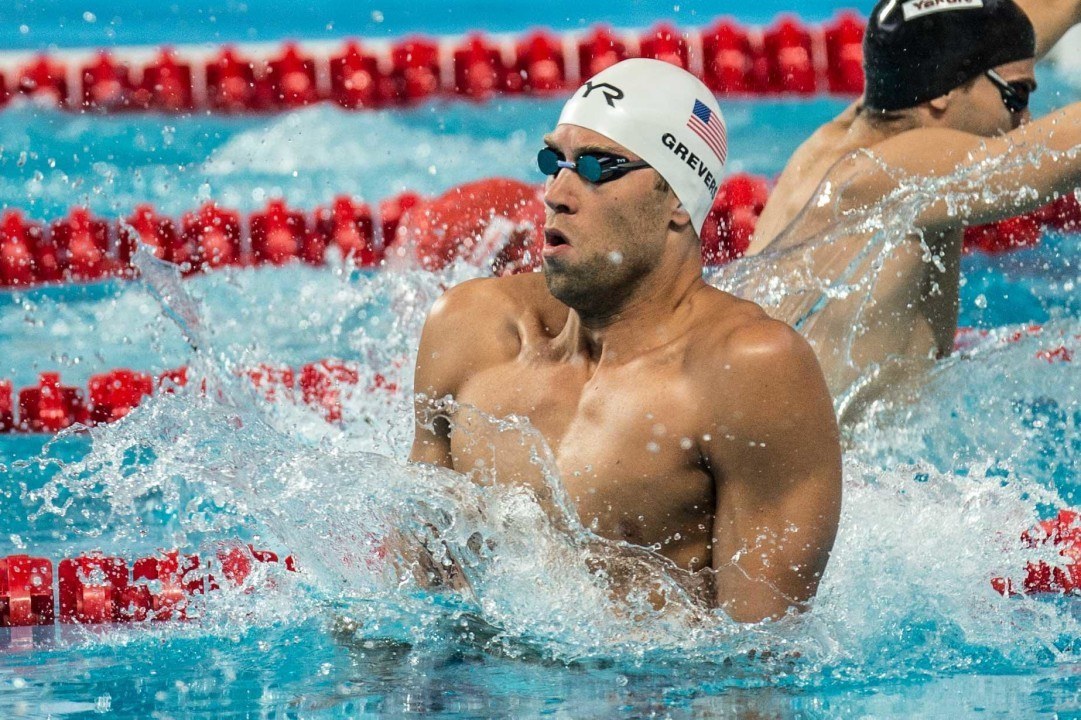Olivier Poirier-Leroy is a former national level swimmer based out of Victoria, BC. In feeding his passion for swimming, he has developed YourSwimBook, a powerful log book and goal setting guide made specifically for swimmers. Sign up for the YourSwimBook newsletter (free) and get weekly motivational tips by clicking here.
It can be infuriating for coaches (and swimmers) to watch their athletes simply swim through a workout. Everyone knows that how a swimmer performs when it comes to meet time is tied to what type of effort is put forth in practice, so why would swimmers squander even a single training opportunity where they could improve?
Instead of feeling like you are simply going through the motions, here are several ways for you to make the most of your time in the water this season:
RELATED: 5 Swimming Posters to Motivate You
1. Have a Pre-Workout Routine
Developing a pre-workout routine is powerful for several reasons. A good pre-workout routine, once repeated enough that it becomes nearly automatic, will get you in the water and your body primed to train like a boss with little thought or need to be motivated.
Pick a simple act to kick off the routine. Something so simple, so banal, that to think up a reason not to do it is close to impossible. Things like—
- Drink sports drink.
- Pack swim bag.
- Listen to a particular song.
The key is to make it super simple and accessible. By doing this habitually you will create a set of triggers that will let your body and brain know that go-time is rapidly approaching.
By consistently applying your pre-workout routine you are teaching your body to expect a certain behavior once the action is completed. “When I do this, then this happens…” or “This is what happens before I train hard.”
Motivation very often only comes after we have begun to start the activity we need to do. Rarely does it strike us out of the blue at 5am on a cold Wednesday morning, pushing us to get out of bed. That motivation and energy flows from action, from starting, so develop a pre-workout routine to sneakily get you get moving even when you might not necessarily feel like it.
2. Track Your Workouts.
If you are serious about wanting to make progress in an area of your swimming, whether it is swimming less strokes per 50, having better breakouts, or the simplest goal of swimming faster, than measuring it is critical.
Saying that you want to be the best swimmer you can be is one thing, but how important can you claim your swimming to be if you aren’t actually tracking what you are doing in the pool?
For instance:
- Swimmers who say they want to be more consistent in practice, but don’t track how many workouts they make it to.
- Swimmers who claim that they want to have a more efficient stroke, but don’t count the strokes they take per lap.
- Swimmers who say that they want to swim a particular time, but don’t monitor how fast they are swimming in workouts to gauge progress.
- Swimmers who say that they want to eat healthier, but don’t write out what and how much they are eating.
This isn’t a case to journal and monitor every last little thing in your training. But you should be noting the couple of things in your swimming that will make the most profound impact on whether or not you achieve your goals.
After all, if you are truly down to improve a facet of your swimming, you oughta be measuring it.
3. Visualize mid-sesh.
I have discussed ways to improve your visualization skills in order to better prepare for competition in a previous post, but did you know that you can use this tool mid-workout to give your swimming a little impromptu jolt?
Oh, yeah.
In research published in the Journal of Strength & Conditioning Research, 16 male sprinters (running, not swimming) were asked to perform 30 meter sprints to be followed by a rest interval.
During the break, half the group were instructed to close their eyes and imagine themselves performing at peak speed and velocity, in their minds running faster than they had ever had before. The control group were asked to count backwards from 1,000 in multiples of 7, rendering any visualization or thought of the sprint ahead incredibly difficult.
The results were overwhelming: 87% of the runners performed better after mentally rehearsing. The advantage was most pronounced the closer the visualization was performed to the task (1-2 minutes), with the effect decreasing to nearly negligible when done outside a window of five minutes before the effort.
The next time a big swim is coming up, or you are doing a series of hard efforts, quickly picture yourself performing at a high level, with killer technique, and reap the benefits of this simple little noodle trick.
About YourSwimBook
 YourSwimBook is a log book and goal setting guide designed specifically for competitive swimmers. It includes a ten month log book, comprehensive goal setting section, monthly evaluations to be filled out with your coach, and more. Learn 8 more reasons why this tool kicks butt.
YourSwimBook is a log book and goal setting guide designed specifically for competitive swimmers. It includes a ten month log book, comprehensive goal setting section, monthly evaluations to be filled out with your coach, and more. Learn 8 more reasons why this tool kicks butt.
NEW: We now have motivational swimming posters. Five of ’em, actually.
Join the YourSwimBook weekly newsletter group and get motivational tips and more straight to your inbox. Sign up for free here.

As the man in the picture says “Smile after every race”. He is a great athlete